Dedicated movement space at home is more valuable than ever—whether for fitness, creativity, or stress relief. A home dance studio offers that freedom to move, rehearse, and express without leaving the house. With the rise of remote routines and personalized wellness zones, carving out even a small area for dance has become a practical and rewarding investment. From mirrored walls to soundproof flooring, there are countless ways to make it functional and inspiring. This post shares the most efficient and stylish home dance studio ideas, helping readers design a space that supports both passion and performance in any home environment.
Convertible Dance Space
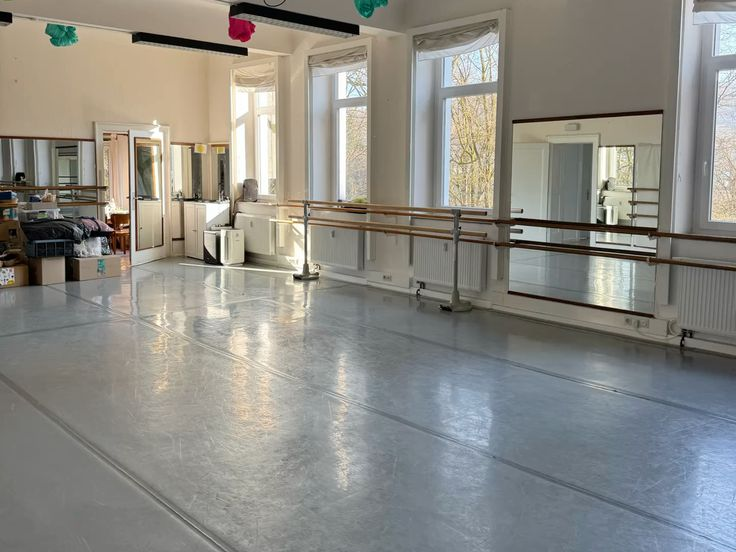
Designing a versatile area that seamlessly shifts between daily use and dance practice ensures optimal space utilization. A foldable wall partition or retractable curtain can help define the dance zone without sacrificing open-floor freedom. Use lightweight, mobile furniture that can be quickly relocated or folded away, allowing you to transition from lounge to studio within minutes. Durable yet smooth flooring like vinyl or laminate makes the space ideal for various dance styles, while ceiling-mounted tracks can store equipment overhead. Flexible room layouts support spontaneous choreography sessions or scheduled routines with minimal setup. Floor-to-ceiling storage behind sliding panels or compact, foldable furniture enhances the dual-purpose nature of the area. Consider adding visual floor markings that fade into the decor for quick alignment checks without disrupting aesthetics. A home dance studio should offer adaptability as much as it does performance potential. This setup balances function and form for dancers seeking practicality and creativity.
Mirrored Wall Panels
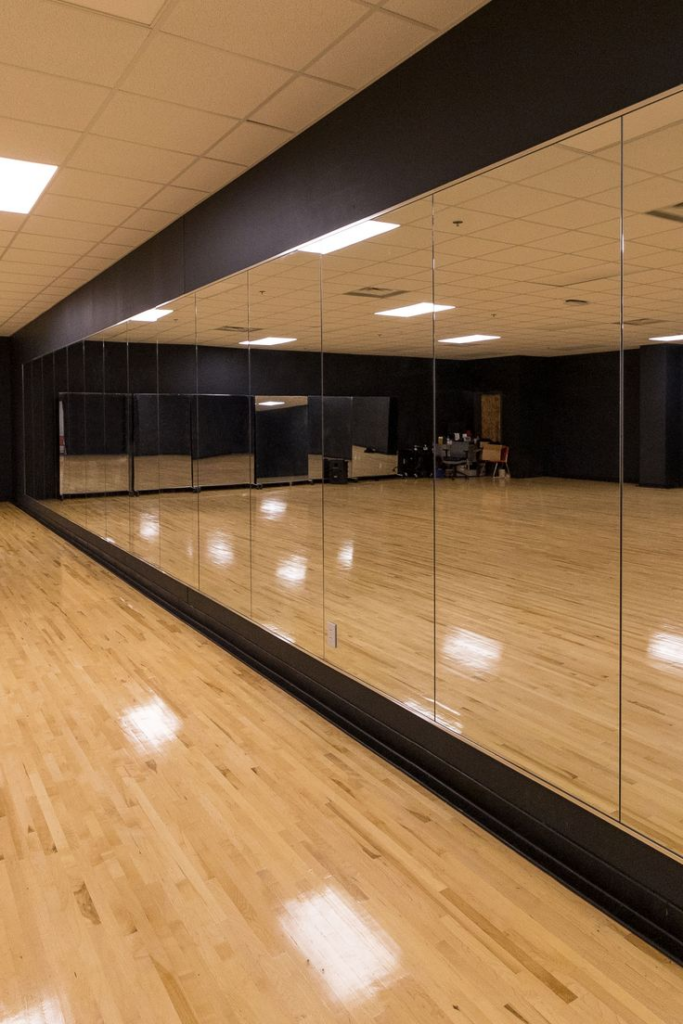
Full-length mirrors serve as essential tools in dance training by offering immediate visual feedback. Instead of installing one large mirror, opt for modular mirrored wall panels for easier installation, better coverage control, and potential portability. These panels can be aligned to span a single wall or strategically placed across corners for a broader visual field. Select shatterproof acrylic or tempered glass for safety without compromising clarity. When mounted with concealed clips, they maintain a sleek, professional appearance that mimics commercial studios. Mirror placement should allow full visibility from head to toe, helping dancers correct posture, alignment, and symmetry during practice. Complement the mirror setup with subtle lighting to minimize glare while preserving reflective quality. Even in compact areas, mirrored panels open up the space visually and psychologically, making the room feel expansive and performance-ready. Their function extends beyond aesthetics—they’re vital for mastering movements and perfecting technique at home.
Portable Ballet Barre

Practicing form, flexibility, and control becomes more effective with a ballet barre that suits your space and needs. A portable ballet barre offers flexibility, making it ideal for home use. Choose adjustable models that allow height modification to suit various exercises, whether it’s pliés or leg stretches. Lightweight aluminum or wood designs provide durability without adding bulk, and rubberized feet help stabilize the barre without damaging floors. Foldable or wheeled options are excellent for compact homes where space needs to be reclaimed after practice. Barres can be temporarily placed in front of mirrors to simulate studio conditions, ensuring proper alignment and posture. Some designs even include resistance bands or extendable arms for added functionality. Whether for classical ballet or general stretching routines, a portable barre becomes an essential and mobile companion in your dance journey. It allows consistent practice without the commitment of permanent installation or room renovations.
Soundproofing Solutions

Noise control is critical in a home dance studio to prevent disturbances while maintaining acoustic integrity. Acoustic wall panels, dense foam tiles, or cork sheets can significantly reduce sound leakage and echo. Focus on treating not just walls, but also ceilings and floors to absorb vibrations. Underlayment padding beneath dance flooring helps minimize impact noise, especially during jumps or footwork-heavy routines. Use heavy drapes or layered curtains on windows to further block sound and insulate the space. Sealing door gaps with weather stripping and installing a solid-core door also enhances sound containment. For music playback, opt for directional speakers that focus audio within the room, preserving clarity while keeping volumes moderate. A well-insulated environment allows dancers to train with intensity without worrying about disrupting household peace or neighbors. Thoughtful soundproofing supports focus, improves music clarity, and ensures your studio operates harmoniously within your home setting.
Integrated Storage Solutions
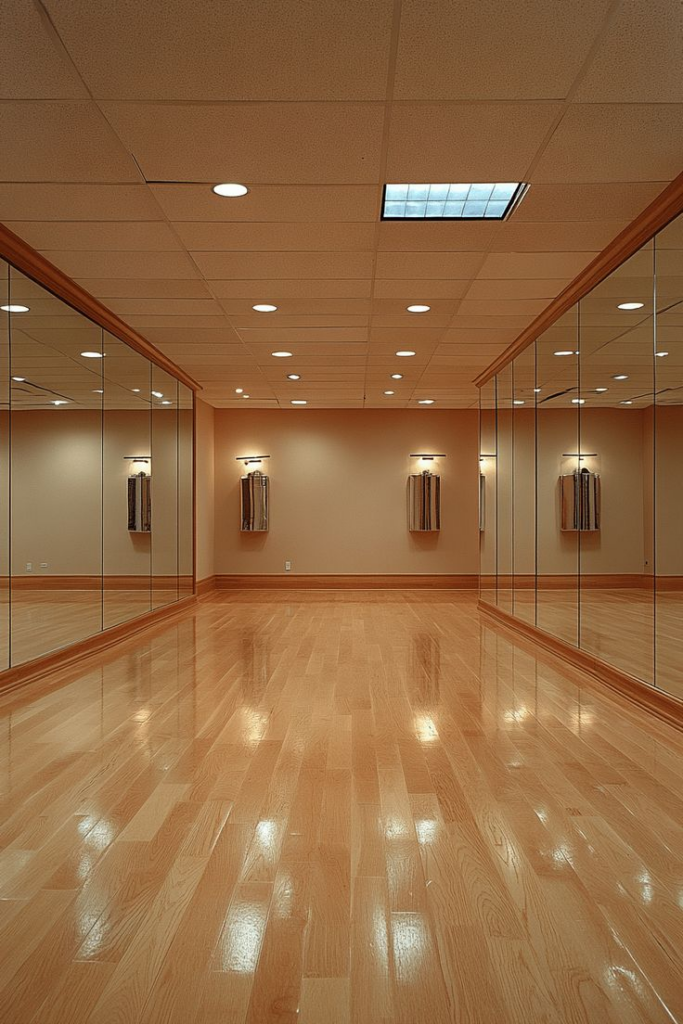
Managing dance gear efficiently starts with intelligent storage built into the studio’s design. Wall-mounted shelves, hidden cabinets, and multi-functional benches with interior compartments keep equipment organized without encroaching on floor space. Floor-to-ceiling shelving units can house shoes, stretching tools, costumes, and props in labeled bins for quick access. Consider cubby-style organizers with open fronts for easy grab-and-go routines. Storage ottomans or seating with lift-up tops serve dual purposes while preserving aesthetics. Hooks and racks on the back of doors offer vertical solutions for hanging resistance bands or workout towels. Mirrors with concealed compartments can disguise storage while enhancing the space visually. Tailor storage solutions to specific dance needs, from yoga mats to tap shoes, creating a streamlined, clutter-free environment that encourages focus. Keeping a studio tidy promotes consistent practice and makes transitions smoother between sessions. Purposeful organization turns any space into a productive, distraction-free dance zone.
Mood Lighting Systems
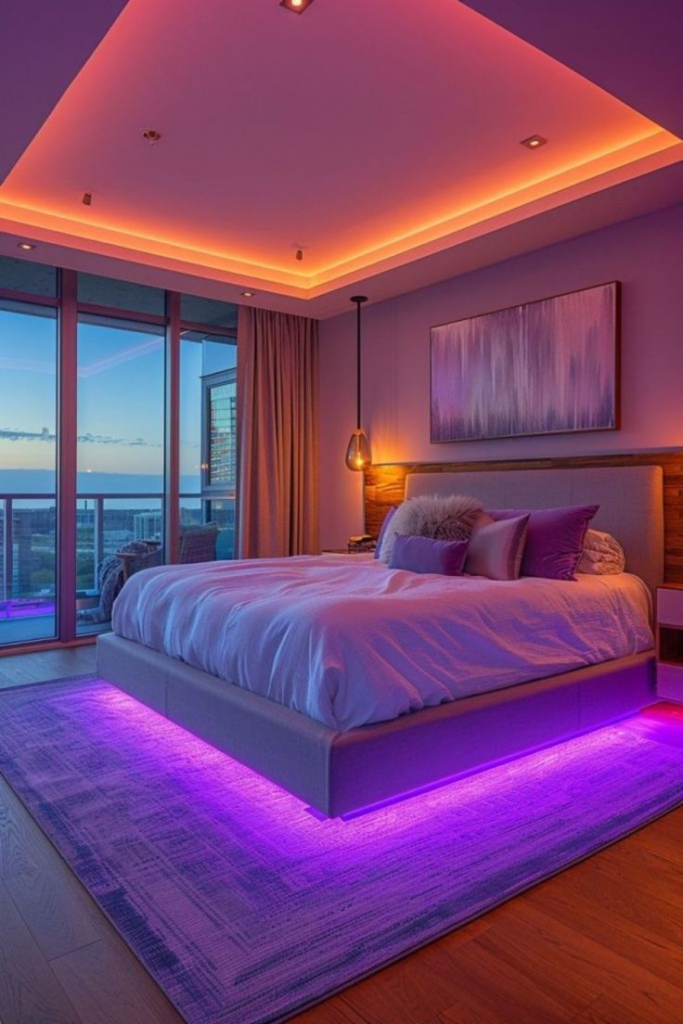
Lighting can dramatically shape the ambiance and function of a home dance studio. Install dimmable LED fixtures that transition from bright white for training to soft hues for warm-ups or cool-downs. Track lighting allows targeted illumination, while recessed ceiling lights keep the floor area unobstructed. Smart bulbs with app control provide flexible customization—ideal for setting a mood during expressive routines or recording sessions. Strip lights along baseboards or mirrors add visual drama without interfering with practice space. Colored lighting effects, when used sparingly, can support contemporary or interpretive dance styles, amplifying the emotional tone. Position lights to reduce shadowing and glare on mirrors to maintain clear visibility. Beyond aesthetics, proper lighting contributes to safety and psychological engagement. An adaptable lighting system not only supports technical training but also enhances creativity and performance preparation. With layered options and programmable settings, you can design an atmosphere that evolves with each movement.
Sprung Flooring Installation

Reducing joint strain and absorbing impact starts with installing a quality sprung floor. These floors provide the resilience dancers need during high-impact movements such as leaps and turns. Constructed with foam or rubber cushioning beneath a solid top layer, sprung floors protect knees, ankles, and backs while enhancing performance comfort. Choose hardwood or Marley surface layers for versatility across dance genres—from ballet to hip-hop. Installation can be permanent or modular, depending on the space and long-term needs. DIY interlocking panels offer a budget-friendly alternative for home studios. Anti-slip finishes are essential for safety and control, ensuring reliable grip during intricate footwork. Even in small rooms, a well-installed sprung floor enhances training quality and reduces injury risk. Proper subfloor leveling and insulation also help manage sound and maintain longevity. A dance studio begins at ground level, and a reliable sprung floor establishes the foundation for consistent, safe practice.
Wall-Mounted Technology

Streamlining training sessions with tech can elevate the home studio experience. Mount a flat-screen display for instructional videos, virtual dance classes, or real-time choreography review. Smart TVs with casting or screen-mirroring capabilities allow seamless connection to mobile devices or laptops. Integrate wall-mounted Bluetooth speakers or soundbars to deliver high-quality audio without consuming valuable floor space. Digital assistants like Alexa or Google Home can be used to manage playlists or control lighting and temperature with voice commands. Some dancers install motion-capture cameras or fitness mirrors for detailed performance analysis. Position these tools at eye level to reduce strain and ensure accessibility during practice. Concealed cable management systems maintain a clean aesthetic while preventing tripping hazards. Merging technology with dance supports both technical refinement and creative exploration. Wall-mounted tech ensures convenience, efficiency, and a touch of modern professionalism within the comfort of your own home studio.
Inspirational Wall Art

Surrounding yourself with visuals that speak to your passion can be a subtle yet powerful motivator. Display motivational quotes, vintage dance posters, or silhouette artwork that celebrates movement and grace. Framed photographs of iconic dancers or personal achievements help create a space that resonates with your dance journey. Use removable adhesive hooks or lightweight frames to change decor as inspiration evolves. Monochrome sketches and minimalist illustrations maintain visual clarity without distracting from practice. Arrange artwork around mirrors or above barres to frame the environment thoughtfully. Large canvases or mural decals can anchor a wall and energize the atmosphere without cluttering the room. Each piece should reinforce dedication, artistry, and expression. A personalized art curation elevates the emotional and creative dimension of dance practice. With the right selection, your walls become more than surfaces—they become daily reminders of discipline, beauty, and the joy found in movement.
Greenery Integration

Bringing in natural elements helps balance physical exertion with mental rejuvenation. Potted indoor plants, such as snake plants or peace lilies, purify the air while enhancing the studio’s ambiance. Vertical gardens or hanging planters make use of unused wall space and contribute to a calming, organic environment. Artificial greenery can also work well if natural light is limited, maintaining the look without added care. Place plants near mirrors to double their visual impact, or position them in corners to soften hard edges of the room. Bamboo arrangements or bonsai trees add a minimalist yet serene touch that pairs beautifully with fluid movement. Greenery not only beautifies the space but also promotes mental clarity, making it easier to focus during rehearsals or cooldowns. Clean lines and curated plant arrangements align with a dancer’s discipline, turning the studio into a more holistic retreat. The result is a healthier, more inspiring dance environment.
Dual-Purpose Furniture

Functional furnishings that serve more than one role offer smart solutions for home dance studios. Choose ottomans that open into storage bins or benches with hidden compartments for stowing gear, shoes, or stretch tools. Fold-out desks or convertible seating can be tucked away easily, creating an open space for movement. Wall-mounted drop-leaf tables provide a work surface when needed but disappear during practice sessions. Opt for compact pieces on casters to reconfigure the room effortlessly based on activity. Sectional couches with removable cushions double as rest areas and impromptu stretching zones. Even lighting fixtures with integrated shelves offer hybrid utility. The key lies in selecting furniture with clean profiles that won’t disrupt the visual openness dancers need. These thoughtfully chosen pieces maintain the space’s aesthetic and functionality, ensuring the studio stays uncluttered and ready for both choreography and daily living. Smart furniture elevates small studios into highly adaptable sanctuaries.
Customizable Wall Decals
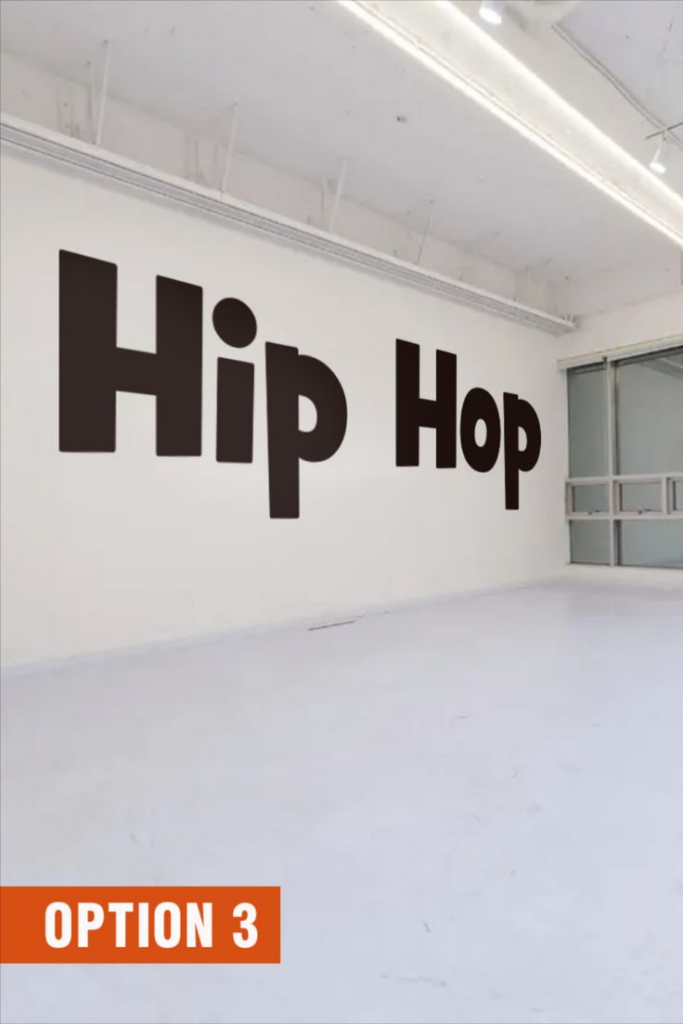
Personal flair adds meaning to your practice space, and customizable wall decals provide a non-permanent way to showcase it. From meaningful quotes to silhouettes of ballet poses or abstract line art, decals offer a tailored touch without commitment. Choose matte finishes to minimize reflection near mirrors or lighting sources. Adhesive designs can be repositioned or swapped seasonally, making them ideal for evolving inspirations. Create a focal wall featuring your name, favorite mantra, or choreography symbols using removable vinyl that doesn’t damage paint. Layer designs around storage or mirrors for added depth without sacrificing practicality. For children or beginners, playful decals make the space more inviting and personalized. These artistic expressions allow dancers to reinforce their identity while maintaining a clean, functional space. With a wide variety of styles and colors available, wall decals can transform plain walls into visual narratives that motivate and encourage movement daily.
Ceiling-Mounted Apparatus

Overhead installations make use of vertical space and introduce advanced training tools to a home dance studio. Mount aerial silks, yoga swings, or resistance cords from reinforced ceiling beams to support strength-building routines. Ensure weight-bearing hardware meets safety standards and is professionally installed, especially in older homes. Use carabiners and swivels for easy adjustments and secure attachment. These features cater to dancers incorporating aerial elements, acrobatics, or suspension training into their regimen. When not in use, retractable rigs or detachable mounts keep the space clear and versatile. Mirrors or cameras can help monitor form from below during exercises. Ceiling integration maintains open floor space while expanding the studio’s potential for diverse disciplines. This vertical extension of the dance zone is especially useful for those combining traditional and contemporary methods. A thoughtfully installed apparatus adds dimension, builds strength, and supports a broader spectrum of motion within a home-based setup.
Climate Control Features

Comfort directly impacts performance, making proper temperature regulation essential in a home dance studio. Install a quiet, energy-efficient HVAC unit or split air conditioner that allows independent control from the rest of the home. Pair it with a smart thermostat for scheduling cool-down or warm-up times before sessions. Ceiling fans or oscillating floor fans improve air circulation, while underfloor heating enhances comfort during winter practices, especially for barefoot dancing. Dehumidifiers help manage moisture levels, protecting floors and preventing equipment damage. Avoid loud appliances that interfere with music clarity or concentration. Position vents away from mirrors to prevent fogging and near high-exertion zones for optimal cooling. Proper climate control enhances focus, reduces fatigue, and ensures dancers can train safely year-round. Whether practicing in a converted garage or a spare bedroom, maintaining ideal air conditions fosters a healthier, more enjoyable practice environment conducive to consistent growth and movement excellence.
Personalized Flooring Designs

Tailoring the floor’s aesthetic to reflect your style boosts both creativity and commitment. Opt for custom vinyl, laminate, or Marley flooring that mimics woodgrain, matte black, or even subtle geometric designs. Paint-on markers or stencils can outline center points or alignment zones without disrupting the flow of movement. Color choices influence mood—warm earth tones add coziness, while cool grays or blacks evoke a sleek studio vibe. For multipurpose use, consider interchangeable floor panels that can flip between decorative and performance sides. Logos or inspirational words embedded into the material add a personal touch without the need for overlays. Textured finishes enhance grip and reduce slippage while blending seamlessly with your chosen color scheme. A custom floor isn’t just about looks—it becomes a statement of purpose. Personalization boosts ownership, encouraging more consistent practice and pride in your home studio space. It turns a functional surface into a meaningful foundation.
